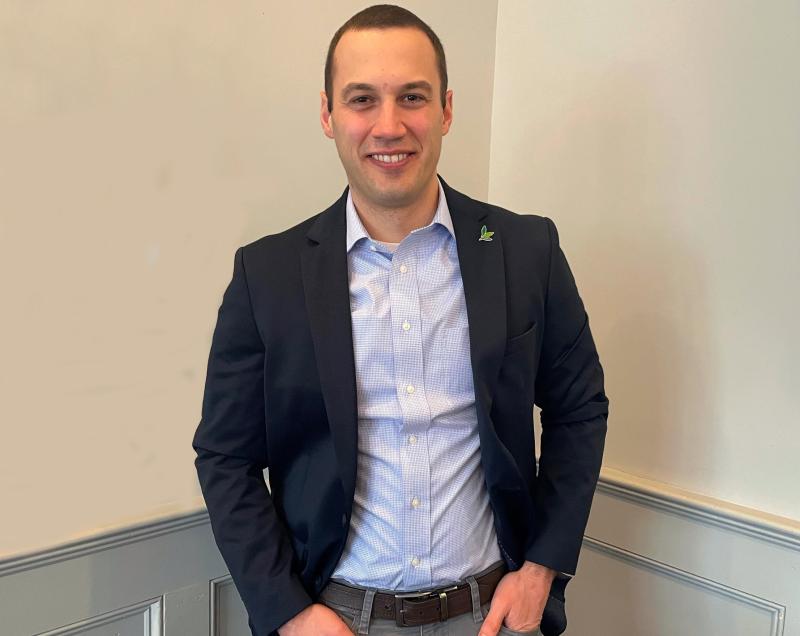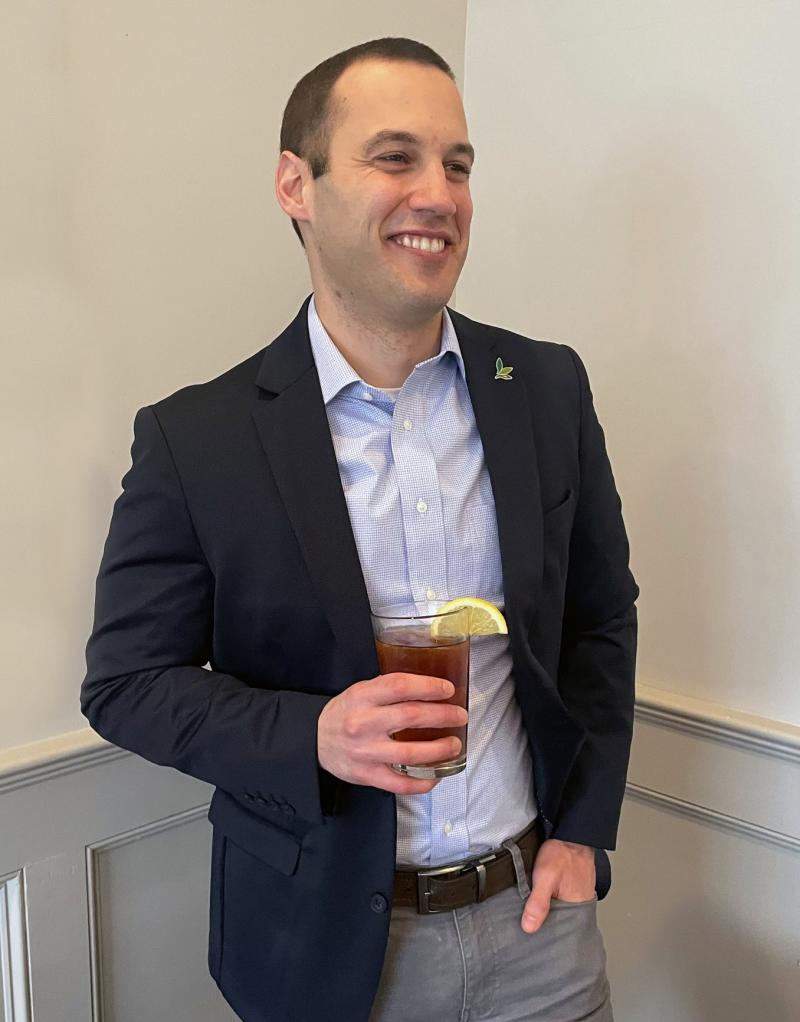World Tea News recently spoke with one of the speakers of the upcoming World Tea Conference + Expo – Art Lopez, marketing director for tea at Finlays Americas.
Lopez will present on “The Journey of Global Tea Trends,” and his session will take place on Tuesday, March 22 at 9:45 a.m.
Speaking on the upcoming World Tea Conference + Expo, Lopez said, “I can’t wait to interact with my industry colleagues. Tea is great on its own, but it really is the people and the relationships that breathe life into the industry, to make a global community of people feel connected.”
Passion and Enthusiasm for Tea
Lopez has been a budding tea expert since his first days at Finlays, a leading independent B2B supplier of tea, coffee, and botanical solutions to beverage brand owners worldwide. Lopez’s passion and enthusiasm for tea began nearly 10 years ago when he started his career at the company, working within tea supply chain management. Over the last decade, he has refined his skill set and expertise, developing an in-depth understanding of both the tea industry and the beverage marketplace.

Finlays, part of Swire Group, was founded in 1750. The company has been sourcing tea since 1817 and producing it since the 1870s. Today, with deep roots across the globe and in-depth experience and expertise, the business is focused on unleashing the potential of natural beverages by helping brand owners bring the best from bush to cup.
World Tea News spoke with Lopez about critical tea industry issues, trends and reaching vertical markets or sellers of tea, among other topics. Here’s what he had to say.
Question: Hi, Art. Thanks for your time! Let’s dive right in. What’s the current state and future of the tea market in the United States, in your opinion?
Answer: The U.S. tea market is in a state of flux. There is a change in consumption habits on tea that is highlighting growth in some areas of the category, but at the detriment to other channels. The most obvious is the short term lift we’ve seen to at-home consumption, mainly in large pack or multi-serve products. This growth was not organic, however. The growth was actually cannibalization from on-premise, food service consumption of tea.
The U.S. tea market has never been more primed for innovation. The category has become relatively flat over the past few years. This opens the door for two possible outcomes. The first is that entrepreneurial brands enter the marketplace and shake up the category to spur new growth. The second is that the industry consolidates through merger and acquisition or through divestiture of legacy brands. I personally am rooting for the first outcome.
Question: What’s the most critical issue in the tea industry right now and why?
Answer: The biggest issue I see in tea right now is the lack of economic sustainability. Simply put, tea is not being sold for the value that it provides. It’s disheartening to think about the amount of time, effort and resources that are poured in to cultivating tea. It includes more than tending to the crop. It includes the livelihoods of those who are in the tea trade – the tea pluckers, the factory workers, the tasters, the logistics teams. Pricing needs to increase to support these aspects of making tea. If it does not, the industry will consolidate, supply will consolidate, and then prices will go up.
Question: In the past, you’ve talked about taking a narrative approach to promoting tea and educating consumers in the United States, to grow the industry. What can you tell us about that? And what advice do you have for tea companies and tea professionals in this area?
Answer: This is a topic that is very close to my heart. There is a gap that exists between how, where, and who harvests tea around the world, and how much of this information is actually understood by the consumer. In the U.S. market, consumers mostly identify tea by its type – black, green or other. This current level of understanding overlooks key differentiating attributes such as origin, terroir, environmental impact, human impact, process method, blend type, cut grade and even brewing method.
My suggestion to my colleagues in the tea industry would be to take the extra step to build out the story of what makes your tea unique. Is it grown at high elevation? Does it support a community in a tea growing region? The stories within tea are endless and are yet to be told to consumers in North America. Being an employee of a company that’s vertically integrated makes this part of my job fun. Finding ways to try and communicate these stories to our customers and brand partners is one of the most challenging and yet most rewarding aspects of my responsibilities.

Question: What’s your take on tea brands using certification logos – such as Organic, Rainforest Alliance, Fair Trade, UTZ – as a way to connect with consumers? Where does that fit in with the narrative approach?
Answer: Certification logos have a place in the connection with consumers and with the betterment of the tea industry, but only scratch the surface of possibility. The interaction between the average consumer and their tea purchase is typically merely a few seconds. Brand marketers are aware of this quick interaction and have come to rely on certification logos to quickly communicate the sustainability messaging to a consumer within those few seconds.
Brand marketers need to go beyond this quick exchange to bring out the full value in tea. Going the extra step to tell stories of origins, people, and process will help to educate consumers. This build will begin to yield product differentiation and deliver unique value.
Question: How are vertical markets learning about tea today?
Answer: Today, it acts as a game of telephone. The tea grower provides information to the buyer, the buyer relays information to the importer/exporter, they then relay it to the blender/packer, they then provide the information to the brand, and the brand markets to its consumers. By the time the brand receives the finished good, the message has been diluted or construed in a way to show the value at the very top of the chain. This hinders the full story that brands are telling consumers. Some companies operate in two or three levels of the value chain. Very few companies operate in all levels of the vertical chain – Finlays being one of them.
Question: What does the tea industry need to do to connect with vertical markets more?
Answer: Step one is understanding the full vertical chain that brings the product to market. Knowing where the tea goes, how it’s used, and knowing where to insert more information about the tea itself is important.
This is a place where the global pandemic may actually provide a positive opportunity for tea to become more transparent. Companies are looking to understand their supply chains now more than ever. This is being done from primarily a risk assessment point-of-view, but companies with a strong marketing presence will analyze this information as well. In this information, they will look for differentiators in product and service to create talking points for their brands. I suspect that the attributes of the tea itself will provide the most opportunity for differentiation and value addition.
Question: Tell us about the current coffee shop scene in the United States, in terms of tea on the menu?
Answer: Tea takes a back seat to coffee in most coffee shops within the U.S. During the summertime, you may see some lighter, refreshing iced teas highlighted on menus. The entire experience within that shop weighs heavily towards coffee. That being said, when I see a challenge, I see opportunity. Tea has an opportunity to create its own identity and consumption habits within the coffee shop.
Question: What can the tea industry do to effectively work with coffee shop owners to elevate tea on the menu and to educate their consumers about tea?
Answer: It will be extremely difficult for tea to overtake coffee during the morning rush. Coffee is a morning ritual for many Americans. However, there is an opportunity for tea during other times of the day. Many coffee shops run promotions during lunch time, afternoon and evening to facilitate movement during off-peak hours. Tea lends itself well in these day-parts.
Coffee shops need to dig deep in uncovering the hidden details in tea that make it unique. Just like what has been done for coffee over the past 20 years. Advertising information such as the origin, the way the tea was produced, how the tea is brewed or served, etc. Highlighting these items during off-peak promotional periods is a starting point. Supporting it with secondary on-premise materials such as tea growing maps and imagery will begin to slowly ingrain itself in to the coffee shop culture.

Question: What global tea trends are you paying attention to right now?
Answer: Sometimes the biggest trends are not the newest or most exciting ones. I look at the global relationship between tea and dairy for inspiration. We know that the U.S. market loves indulgent, dairy based food and beverages. Combine this knowledge with global tea consumption habits in India, Thailand, Japan and even Europe and you end up with some very indulgent possibilities. Chai lattes, Thai lattes, matcha lattes or even a “London Fog” are all beverages that have been around for centuries. I ask myself, “Who is really focusing on promoting these indulgent tea beverages to U.S. consumers?” The answer is not many.
But amid rising green coffee prices, these types of indulgent, dairy-based tea beverages may emerge as a new option for traditional coffee customers, particularly in food service. This dynamic is something I will be keeping a close eye on over the next 12 months.
Question: What can you tell us about Finlays and the products/solutions it offers?
Answer: Finlays is unusual in the tea world because it operates in all levels of the supply chain – growing, harvesting, processing, shipping, packing, extracting and solution development. Given the full depth of involvement throughout the chain, Finlays can be viewed as a valuable business to business partner on many different ingredients, goods, services or solutions.
In the USA, there is a fully developed market that is in high demand for full solution providers. We aim to take the complexity out of the world of tea by using a solutions-based approach. Our customers know their brand and the end-use product. We then work backwards to ensure our supply chain, ingredients, and tea development expertise can be combined to create finished solutions for those brands to go-to-market with.
Question: Finlays believes that sustainable sourcing should be a top priority. How is that critical for the beverage industry?
Answer: It is imperative. A sustainable future is the only future we have. It’s very easy for us to forget that agricultural products such as tea that make up a daily part of our lives rely on a delicate ecosystem to thrive. This ecosystem is not just in the traditional biology sense, but in the economic and cultural sense as well. If the environment is not supported, the crops will not grow. If the farmers are not supported, they will stop planting. If the community is not there to support the farmers and the fields, then that agricultural operation will go to another livelihood that will support. It’s easy to forget this when you’re only focused on getting a warm beverage during your morning commute.
Question: How is Finlays innovating?
Answer: Innovation is a big word that can mean many different things to many different people. It can range from a small process improvement on a packing line to the discovery of a brand-new tea varietal. Finlays’ global footprint in tea means that we run the full range of these types of innovation.
On a global standpoint, I’ve always found the work of our agricultural sciences group in Kenya to be fascinating. There they study all the attributes of tea and are constantly performing experimentation with new clone types, growing environments, and even alternate crops. More locally, Finlays Americas has been focused on innovation at the customer level. Focusing on new ways to create finished or near finished solutions that our marketplace wants or needs.
Question: Thanks for your time! We’re looking forward to seeing you at the upcoming World Tea Conference + Expo in Las Vegas. Last question: What does the future hold for Finlays and the tea industry?
Answer: Well, Finlays has been in existence since 1750. A company does not last for 272 years without being able to adapt and overcome changes or adversity. The tea industry has been relatively flat for the past few years. This makes it ripe for either consolidation or innovation to shake up the industry. Part of my job at Finlays is to help identify what that change will be and keep Finlays ahead of it. I’ll let you know in a few years if I was successful or not. In all seriousness, I can say that Finlays is well situated to leverage its vertical integration to stay ahead of or even influence what these changes might be.
To learn more about Finlays, visit Finlays.net.
Don't Miss the World Tea Conference + Expo,
March 21-23, 2022
To learn about other key developments, trends, issues, hot topics and products within the global tea community, plan to attend the World Tea Conference + Expo, March 21-23, 2022. The event will be celebrating its 20th anniversary, in addition to being co-located with Bar & Restaurant Expo. Visit WorldTeaExpo.com.
To book your 2023 sponsorship or exhibit space at the World Tea Conference + Expo, contact:
Veronica Gonnello
(for companies A to G)
e: [email protected]
p: 212-895-8244
Tim Schultz
(for companies H to Q)
e: [email protected]
p: (917) 258-8589
Fadi Alsayegh
(for companies R to Z)
e: [email protected]
p: 917-258-5174
Also, be sure to stay connected with the World Tea Conference + Expo on social media, for details and insights about the event. Follow us on Twitter, Facebook, Instagram and LinkedIn.
